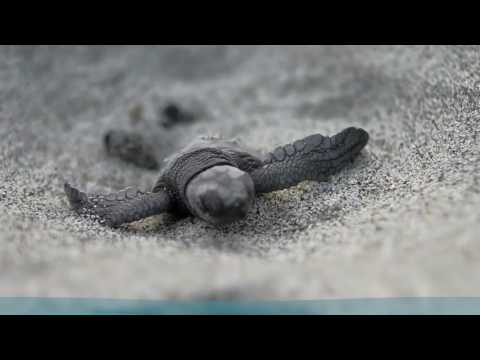Florida is a haven for sea turtles, and among its many beaches, Juno Beach stands out as the most popular nesting site. This beach offers a unique opportunity to witness these magnificent creatures in their natural habitat.
Each year, Juno Beach becomes a bustling nursery for various sea turtle species, drawing nature enthusiasts and conservationists alike.
In this blog post, we’ll explore why Juno Beach is a prime destination for sea turtle nesting and what visitors can expect during this remarkable natural event.

Overview of Sea Turtles in Florida
Florida has the world’s largest loggerhead nesting population and is hugely vital for other sea turtle species as well. About 90% of sea turtle nesting in the continental U.S. happens in Florida.
The most common sea turtles found in Florida are:
- Loggerhead Sea Turtles: Loggerheads are listed as threatened under the Endangered Species Act. They have reddish-brown shells and can weigh over 300 pounds. Florida hosts over 90,000 loggerhead nests per year.
- Green Sea Turtles: Green turtles have olive-colored shells and can weigh up to 350 pounds. Many of the world’s green turtles nest in Florida, with about 35,000 nests per year.
- Leatherback Sea Turtles: The largest turtle species, leatherbacks can reach 6 feet long and 2,000 pounds. Their flexible, rubbery shells help them dive deep. They nest sporadically in Florida.
Several other species, like hawksbill and Kemp’s ridley sea turtles, also nest in Florida in smaller numbers. The state’s sandy beaches provide ideal conditions for turtles to lay eggs and for hatchlings to journey out to sea.
Top Beaches in Florida for Sea Turtle Sightings
Some beaches stand out for their large sea turtle populations and excellent sighting opportunities.
Archie Carr National Wildlife Refuge
Archie Carr National Wildlife Refuge near Melbourne Beach hosts the most loggerhead sea turtle nests of any beach in the Western Hemisphere. Over 20% of Florida’s green turtle nests also occur here.
The refuge stretches across 20 miles of coastline. At certain times in summer, hundreds or even thousands of turtles can emerge from the ocean in a single night to lay eggs. Archie Carr provides unique access to observe sea turtles in their natural habitat.
Canaveral National Seashore
Canaveral National Seashore lies just north of Archie Carr NWR on Florida’s Atlantic coast. It hosts over 17,000 sea turtle nests each year.
Loggerhead sea turtles are most numerous, but leatherbacks and green turtles also nest here. Canaveral is the only national seashore allowing recreational turtle watching with flashlights on summer nights, offering spectacular viewing opportunities.
Permitted Turtle Watches allow small groups to join rangers searching for females coming ashore under cover of darkness. Hatching nests draw crowds jostling for views in July and August. The seashore also has a sea turtle conservation program and rehabilitation facility.
Juno Beach
Juno Beach, just north of West Palm Beach, is another haven for sea turtle nesting within Loggerhead Marinelife Center’s monitoring zone. Their data shows over 4,000 loggerhead nests at Juno Beach per year, along with good numbers of greens and leatherbacks.
The center has state and federal permits for sea turtle conservation and conducts educational programs. Visitors to Juno Beach can take part in the Great Turtle Race fundraiser by sponsoring nests. Turtle walks and hatchling releases also allow people to participate in sea turtle conservation.
Other Notable Beaches
Many other Florida beaches have significant sea turtle nesting and are ideal places for sightings. For example, Jupiter Beach hosts over 2,500 loggerhead nests per year.
The beaches within Everglades National Park contain some of Florida’s most important green turtle rookeries.
John D. MacArthur Beach State Park and Boca Raton’s Gumbo Limbo Nature Center have high densities of nesting turtles and active conservation programs. There are also many opportunities for the public to observe the nesting and hatching season.
Conservation Efforts
Many organizations in Florida work actively to protect sea turtles and their nesting habitat. State parks monitor and safeguard nests.
Groups like the Sea Turtle Conservancy and the Sea Turtle Survival League conduct research and advocacy. Hundreds of volunteers across Florida help document and track nests during sea turtle season.
Conservation measures used in Florida include monitoring beaches during nesting season, marking and barricading nests, relocating at-risk nests, releasing hatchlings disrupted by lights, and educating the public. Light pollution is also reduced by substituting low-wavelength and shielded lights along nesting beaches.
These efforts have paid off through increasing sea turtle populations, giving hope for species recovery. But turtles still face significant threats from development, marine debris, pollution, and climate change.
Continued commitment to conservation programs is crucial so sea turtles have safe places like Florida’s beaches to nest.
Best Times to Visit and Viewing Tips
May through October is sea turtle nesting and hatching season in Florida. The peak window for witnessing nesting by female sea turtles is typically May and June, while hatchlings emerge en masse starting in July.
For the best experience seeing sea turtles, visit official turtle watches or join guided hatchling releases with conservation organizations.
Make sure to follow guidelines like hiding lights and maintaining a distance so as not to disturb turtles. The joy of seeing a turtle hatchling scurry out to sea under the moonlight is unmatched!
Conclusion
As a pivotal sea turtle nesting habitat, Florida offers fantastic sighting opportunities thanks to extensive conservation efforts.
Canaveral National Seashore, Archie Carr National Wildlife Refuge, and Juno Beach stand out for their large turtle populations and hatchling emergence events.
Witnessing threatened sea turtles continuing the ancient cycle of nesting as our climate changes is an inspiring, hopeful experience not to be missed in Florida.

